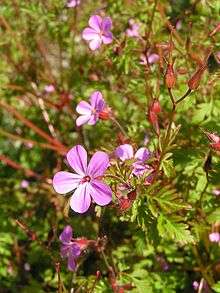Geranium robertianum
| Geranium robertianum | |
|---|---|
 | |
| Scientific classification | |
| Kingdom: | Plantae |
| Clade: | Angiosperms |
| Clade: | Eudicots |
| Clade: | Rosids |
| Order: | Geraniales |
| Family: | Geraniaceae |
| Genus: | Geranium |
| Species: | G. robertianum |
| Binomial name | |
| Geranium robertianum | |
| Synonyms | |
|
Robertiella robertiana | |
Geranium robertianum, commonly known as herb-Robert,[1] red robin, death come quickly, storksbill, fox geranium, stinking Bob, squinter-pip (Shropshire), crow's foot, or (in North America) Roberts geranium, is a common species of cranesbill native to Europe and parts of Asia, North America, and North Africa.[2]
Description
.jpg)
It grows as a procumbent to erect annual or biennial plant, up to fifty centimetres high, producing small, pink, five-petalled flowers (8–14 mm in diameter)[3] from April until the autumn. The leaves are deeply dissected, ternate to palmate,[3][4] and the stems often reddish; the leaves also turn red at the end of the flowering season.
Distribution
Its main area of distribution is Europe from the north Mediterranean coast to the Baltic and from the British Isles in the west to the Caucasus in the east, and eastern North America.[5] Geranium robertianum is common throughout Great Britain and Ireland in woodland, hedgerows, scree and maritime shingle.[3] It grows at altitudes from sea level to 710 metres (2,329 ft) in Teesdale, England and above 2,100 metres (6,890 ft) in parts of mainland Europe on calcareous alpine screes.[6]
Uses
In traditional herbalism, herb Robert was used as a remedy for toothache and nosebleeds[7] and as a vulnerary (used for or useful in healing wounds).[8] The name has been explained as a reference to abbot and herbalist Robert of Molesme. Freshly picked leaves have an odor resembling burning tires when crushed, and if they are rubbed on the body the smell is said to repel mosquitoes.[8] The active ingredients are tannins, a bitter compound called geraniin, and essential oils. It was carried to attract good luck, and due to its analogical association with storks, to enhance fertility.
References
- ↑ BSBI List 2007, Botanical Society of Britain and Ireland, archived from the original (xls) on 2015-01-25, retrieved 2014-10-17
- ↑ BONAP’s Taxonomic Data Center (TDC) North American Vascular Flora
- 1 2 3 Stace, C. A. (2010), New Flora of the British Isles (Third ed.), Cambridge, U.K.: Cambridge University Press, p. 348, ISBN 9780521707725
- ↑ Blamey, M.; Fitter, R.; Fitter, A (2003), Wild flowers of Britain and Ireland: The Complete Guide to the British and Irish Flora., London: A & C Black, p. 174, ISBN 978-1408179505
- ↑ Anderberg, Arne, "Geranium robertianum L.", Den Virtuella Floran, Naturhistoriska riksmuseet, Stockholm, Sweden
- ↑ Tofts, R.J. (2004), "Biological flora of the British isles No. 234 Geranium robertianum L", Journal of Ecology, 92 (3): 537–555, doi:10.1111/j.0022-0477.2004.00892.x
- ↑ Foster, Steven (2006), Desk Reference To Nature's Medicine, Washington, DC: National Geographic Society, pp. 210–11, ISBN 0-7922-3666-1
- 1 2 Milliken, W.; Bridgewater, S. (2004), Flora Celtica, Edinburgh, U.K.: Birlinn Ltd., p. 221, ISBN 1841583030
Bibliography
- Blanchan, Neltje (2005), Wild Flowers Worth Knowing, Project Gutenberg Literary Archive Foundation
- Isabell Shipard (2003), How can I use HERBS in my daily life?
- Peter Loewer (1991), The Wild Gardener


External links
| Wikimedia Commons has media related to Geranium robertianum - herb Robert. |